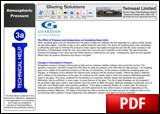

The Effect of Pressure and temperature on Insulating Glass Units
When insulating glass units are manufactured, the panes of glass are relatively flat and separated by a spacer profile around the perimeter edges. A quantity of gas or air is sealed inside the unit cavity. The nature of insulating glass units necessitates a sufficiently good seal to minimise the amount of water vapour that passes through the seal into the cavity resulting in the formation of condensation inside the unit, since when this occurs the unit is deemed to have failed. The seal should also minimise the passage of any other gas from either leaving or entering the unit cavity. Consequently, there are two separate effects that can produce distortions and stress in the glass.
Changes in Atmospheric Pressure
Atmospheric pressure changes continuously as high and low pressure weather systems move across the country. The variation in pressure commonly ranges from 950 mbar for deep low pressure and 1030 mbar for high pressure. An insulating glass unit is sealed at the particular pressure on the day of manufacture. As the pressure outside the insulating glass unit changes, an imbalance occurs between the internal cavity pressure and the pressure outside. Where the glass is relatively stiff in relation to the dimensions of the pane, for instance as with smaller sizes of units, the pressure differential generates stress in the glass. This stress, sustained for the duration of a particular weather system that generated the pressure differential, may be sufficient, in some cases, to cause fracture of the glass. The risk of glass breakage can be increased if the perimeter edge seal is itself a rigid material, since this tends to stiffen the glass, although breakages occasionally occur in units with more flexible seals under extreme conditions. If the glass is relatively flexible, as in larger units, the pressure imbalance causes deflection of the glass panes, and both panes tend to bow either inward or outward depending on the prevailing pressure difference. The edges of the panes are held in position by the edge seal and are unable to move so the unit becomes either dished or bowed respectively and reflections viewed in the glass will become distorted.
Changes in Temperature
After the insulating glass unit has been installed, the temperature of the glass panes and the gas inside the cavity will continuously change. This results from variations in the ambient external temperature and the effects of solar radiation which, if present, will heat the glass and gas inside the unit.
The effect of temperature increase on the gas is to increase the gas volume and pressure, the opposite occurs when the temperature falls. The unit was sealed at a particular temperature, so any variation from that temperature will change the volume and pressure of the gas in the cavity resulting in bowing or dishing similar to the effect of changing atmospheric pressure.
Glass Overstressing
In natural weather conditions, the two effects combine, and depending on conditions will tend to cancel each other or reinforce each other. In particular, low pressure during warm weather and high pressure in cold weather produce the most extreme conditions.
In the extreme conditions when the effects combine to reinforce each other they produce stresses in the glass and the edge seal which may result in the glass being overstressed and it will fracture.
The fractures caused by this phenomenon are typically shaped along the longer dimension of the unit, the position of the fracture in the short dimension of the unit depending on the flexibility of the sealant.
In both the above situations, the fractures originate from the central portion of the fracture and run in both directions, sometimes not reaching the edge of the glass.
JMP07/02/08 REF: TECHNICAL SHEET 033 TECHNICAL ADVISORY SERVICES
Extract from document supplied by Guardian Industries Goole Ltd.
Rawcliffe Road
Goole, East Riding of Yorkshire, U.K.
DN14 8GA


